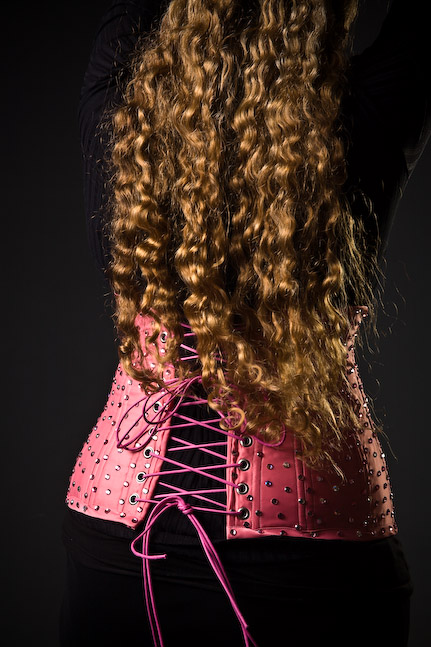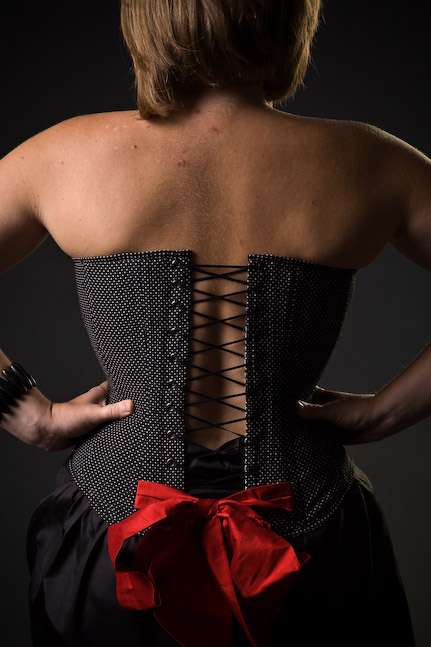| Advanced Corset Design
The Fashion eZine - Corsetry
Corset Design Classes
By Charles Moffat - March 30th 2009. I met today with 27-year-old fashion designer and corseteer Carrie Hayes (known by her students as Carrie the Corset Lady) and talked about the finer details of corset design. Sounds complicated? It can be. 80% of corsetry is perfecting your pattern design and according to Carrie Hayes it takes a lot of time and effort to get into the business. Why is this? Its because generally speaking a lot of corseteers don't want to share their tricks of the trade. Its a bit like the Magicians' Code and not sharing the secrets of how you do something. But if that's the standard, Carrie Hayes is breaking it. She's the teacher of the Advanced Corset Making class in Toronto Canada, the first class of its kind in North America. For $375 Canadian, designers get a 3 hour session every Thursday for 8 weeks and get taught all the accumulated tricks of the trade Carrie Hayes has picked up.
(Note: The photos used on this site are from Carrie Hayes' Advanced Corset Making class.) Normally to learn corsetry a person has to learn by taking apart corsets and putting them back together again, plus old books on the history/design of corsetry. Its not an easy field of fashion to get into, and its also one of the most challenging. Carrie learned corsetry the hard way and has been making corsets since she was 17 and growing up in Wiarton Ontario (home of famed groundhog Wiarton Willie). She later went on to study fashion design at the International Academy of Design & Technology in Toronto for 2 years, followed by 8 years in the fashion industry and now runs her own business creating fashion collections. The young and stylish entrepreneur says she likes difficult things and loves a challenge, part of the reason she was drawn to corsetry, which relies much more on a hardy construction and pattern design than regular fashion design. Normally clothes is designed to fit the body, but with corsetry your aim is to reshape the body using fine stitching, fabric, glue, metal (and for traditionalists whalebone), but at the same time it has to fit well. Carrie says you can tell the difference between a well-made custom corset and a run-of-the-mill mass production one because anyone can see gaps and ill-fitting problems. A well-made custom corset will also be significantly more comfortable to wear and have a good snug fit, whereas a generic corset bought in a fetish shop won't fit properly and can be quite painful.
Seeing that there was demand for it, Carrie decided she wanted to teach a course on how to make corsets, becoming in 2007 the first person in North America to teach a course on advanced corset design. Today she gets contacted by people all over Canada and the United States looking to take her course and was even asked "When are you coming to New York?" Sorry folks, Carrie is staying in Toronto, but if you're absolutely serious about learning corset design you can always visit Toronto and take the course. And if you can't visit Toronto, Carrie recommends checking out your local corset designers, giving the advice: "Buy locally, because you will get better quality and check out their past work for gaps and ill-fitting bits to see how professional they are." She also recommends fellow Toronto designer Puimond Yee, whom Carrie says "does an excellent job". "If people show you their best work and it looks bad that is a warning sign to steer clear, because what about everything else they didn't show you." - Carrie Hayes. There's a lot of amateur corseteers out there apparently, and Carrie has taken on the task of helping to educate new corset designers in hopes of creating a new generation of innovative corset designers who will share what they've learned instead of hoarding it. Carrie's courses have a max of 10 students and in addition to the $375 for taking the course you will also need approx. $80 to $100 CDN for materials. (Note that this is still less than buying a custom-made corset, which typically can cost between $600 to $900.) Carrie recommends new corset designers focus on using silk for their corsets and try PVC and leather later on after they've developed their skills more. Carrie's students come from all walks of life, including working-mothers, fashion designers, gothic fashionistas, fetish-PVC fans and transgendered men. Her teaching style is informal, but she has a strong emphasis on being detailed, informative and helping her students to design and create a quality end product.
Corsetry Glossary
The construction of a quality custom corset is what truly sets it apart from modern day run-of-the-mill factory corsets. Using quality materials the corsets are carefully stitched together with steel boning and strong tight lacings. For people who know nothing or little about corsets it helps to have a glossary to have a better understanding of what to look for when buying a corset, and also what to watch out for.
Abdomen The most important of the cavities of the trunk, from the corset fitter's point of view. It contains the stomach, intestines, liver, spleen, pancreas, and kidneys.
Abdominal Development
Abdomen, High
Abdomen, Pendulous
Belt, Girdle or Waspie
Bandeau
Boning
Known as "Stay or Stays" In Victorian Times these would be made of Whale Bone. These have been replaced in traditional corset making by "Sturdy Flexible Spiral Stainless Steel Inserts" and "Flexi Stainless Steel Inserts" which are tipped to prevent fraying when fitted inside the garment. These maintain the control in the corset without the discomfort. The flexi steel is a straight flat steel which is used in the back of the garment to give support without too much deviation. The spiral steel inserts are made of a woven wire construction this is for flexibility and these are used in the side and the front of the garment to allow full movement whilst maintaining shape and form.
Brassiere, Deep
Busk
|
|
 Bust
Bust
General term used in referring to the upper part of the body including the breasts.
Bust, Dropped or Pendulous
Bust Development
Buttocks
Chest Cavity
Cording
Corselette
Coutil
Diaphragm
Elasticated
Flossing
Garters
Gluteal Fold
Grommets
Hip-spring
Lacing
Modesty Panel
Pantie-girdle
Pelvic Cavity
Pelvis
Posture, Postural Tone
Roll-on
Semi-Step-in
Thigh-spread
Torso
Corset Wearing and Care
Lacing Up Once this is done the second person will then draw the lacing to your shape. Once this is done and tied off you will then be able to remove and re-fit the corset without adjusting the lacing.
After Wear
Cleaning
Should you acquire a traditional corset cherish it as it is a stylish sophisticated garment which will give you many years of pleasure.
Corsetry LinksThe History of the Corset & Brassiere The Corset Waist: A waist is a terrible thing to waste Chastity Belts & Corsets: The Next Thing in Fashion?
| |







